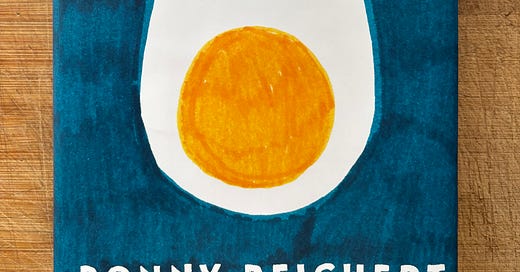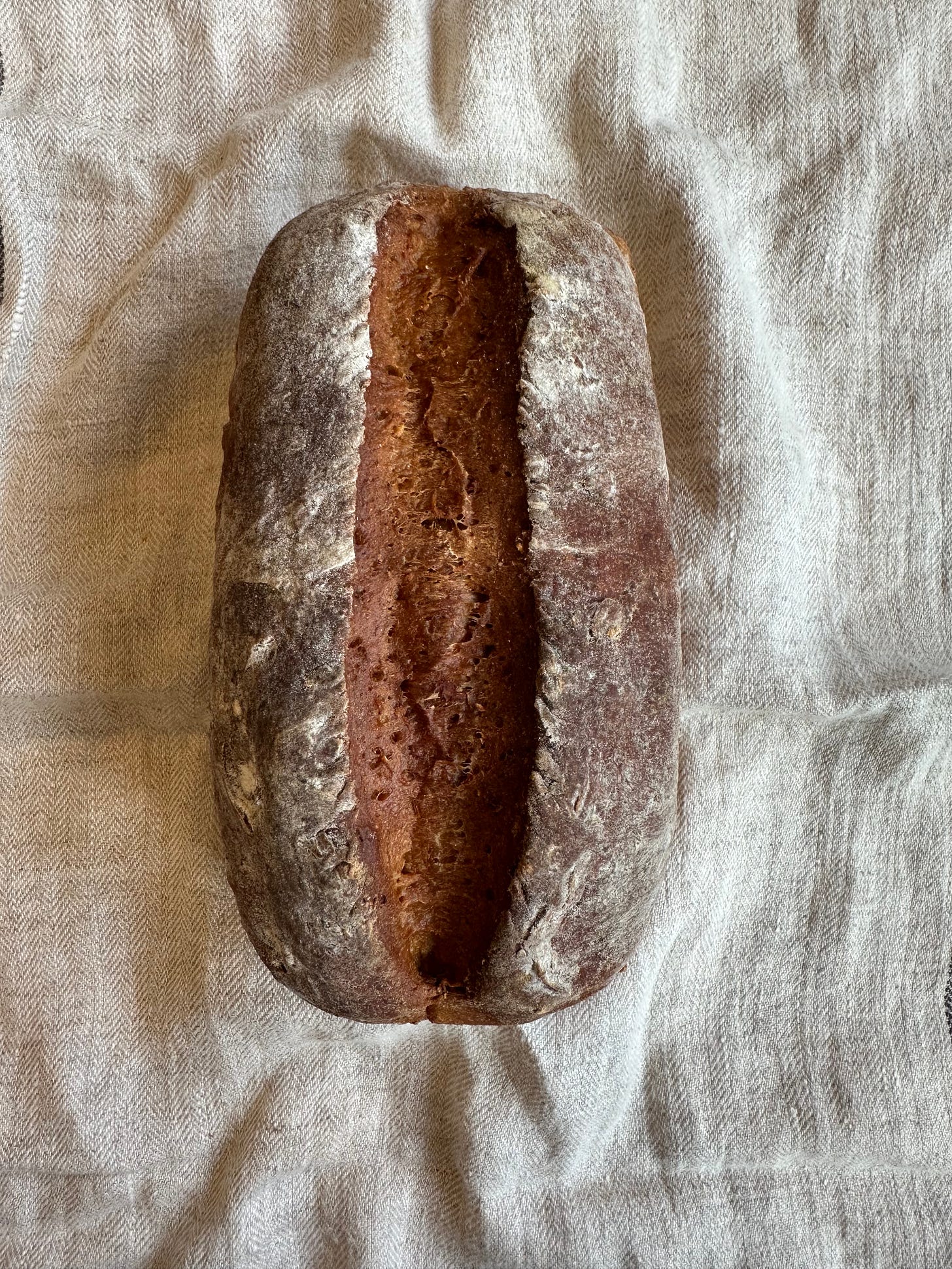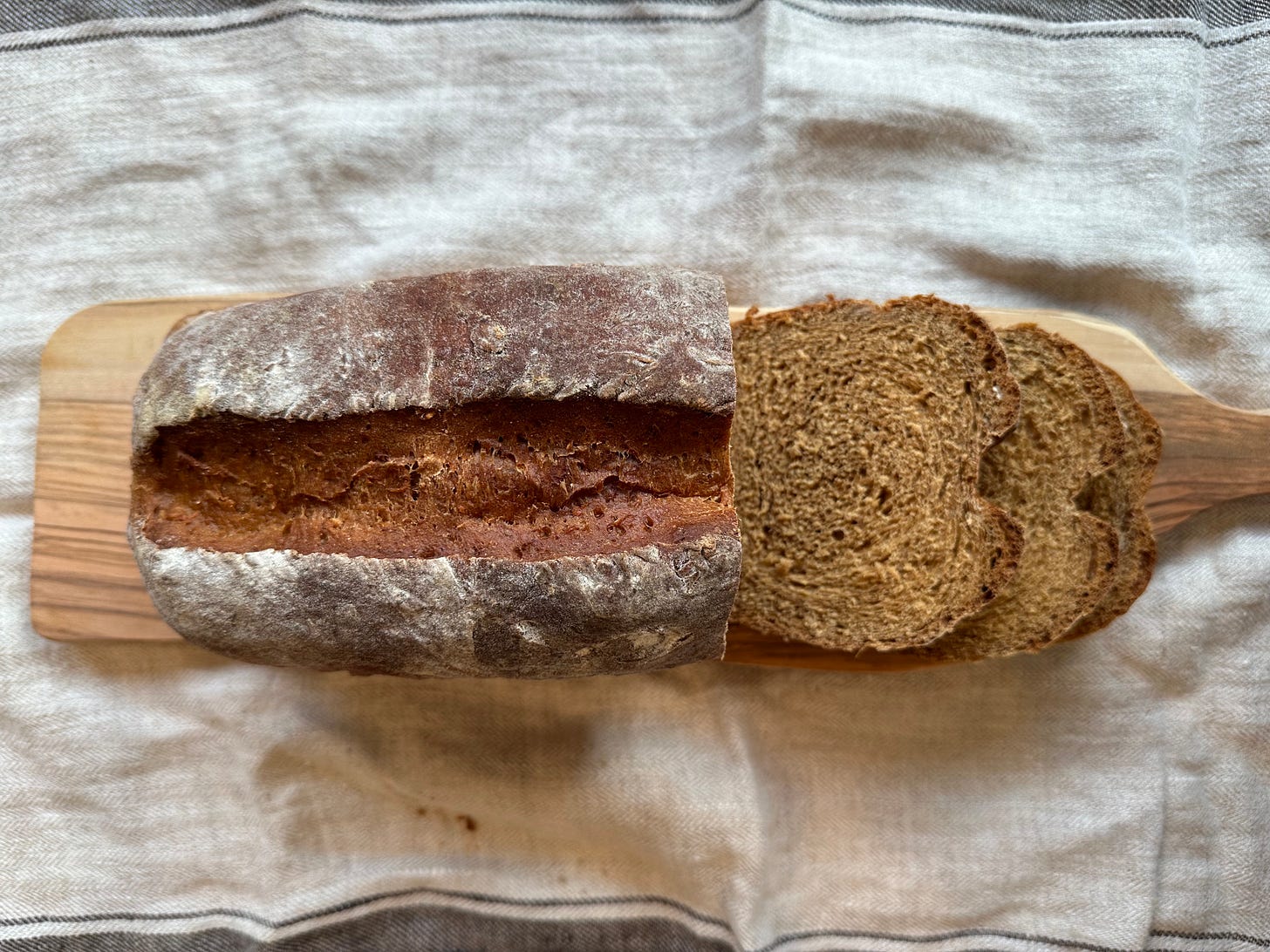How to Share an Egg: a True Story of Hunger, Love, and Plenty
An extraordinary new food memoir by Bonny Reichert plus an exclusive recipe.
Back in 2016, I took a big step out of my comfort zone and said yes to a very kind invitation from a wonderful chef, Romy Gill, to take part in a charity dinner, where some of my food heroines were cooking a feast to raise funds for Action Against Hunger. The evening was recorded for the BBC Radio 4 Food Programme, and each of the women cooking that night was interviewed by the programme’s presenter, Sheila Dillon. Being the least experienced, and completely unknown, chef, I felt completely inadequate taking part. Thinking, “Why would Sheila Dillon want to talk to me?”, I sort of avoided raising my hand up when the question “Who wants to go next?” sounded around our prep kitchen. Finally, I was the last one left, so sheepishly I went in. The conversation acquired an entirely new tone when Sheila asked, “What does hunger mean to you?” and out flowed the story of my great-grandma, Rosalia, and my grandpa, Yuri, who survived WWII and the Holocaust in Ukraine. I spoke about their experience of hunger during the war and how Rosalia survived the persecution to live into old age; always cooking, feeding, and pretty much existing in the kitchen, at home and at work. My story ended up almost unedited in its entirety in the programme, and shortly after it aired I got a message on social media from a literary agent, asking whether I’d like to write a book about Rosalia. This was 9 years ago now, and looking back I can’t believe I said “no!”. I guess I was not ready. But this message has planted, or rather watered, the existing seed, which continues to germinate.
I delved into research, purchasing every Jewish family memoir I could get my hands on. All these powerful stories moved and inspired me deeply, but none of them really landed for me, or made me feel like my own experience had a home. And then a book found me…
I wasn’t actively looking for new memoirs to read, but a book kept popping up in my social media feed. The title immediately caught my eye—how could it not?
How to Share an Egg: A True Story of Hunger, Love, and Plenty
Written by Bonny Reichert, a Canadian writer and chef, the book is centred around the history and legacy of the Holocaust. While this is what initially made me buy the book, as soon as I began reading I realised this work resonated with me on so many new, unexpected levels. This is the type of book I wish I had written. Or perhaps I will write in 10 years’ time…
In a nutshell, ‘How to Share an Egg’ is about Bonny’s relationship with her Holocaust-survivor father, Saul; it tells the story of his experience of the war in the ghettos and the death camps of Poland, of his migration to Canada, as a sole survivor from his immediate family, where he started a new family and a food business with Bonny’s mother and grandmother. Yet, even writing this I feel how I’m not doing the book any justice. It is about so much more, and I will try to unpick it here.
It is a book about the difficulty—and at times, the impossibility—of writing a book. It is an attempt to resurrect her father’s family through storytelling and cooking. It is a work-in-progress of healing from the unspeakable generational trauma that haunts Bonny’s life—yet also gives her an inexplicable, almost compulsive drive to keep confronting it, and to keep writing.
It is a book about womanhood and motherhood. About Bonny’s relationship to her maternal Ukrainian grandma (baba), Sarah, who raised her, and her almost phantom-like connection to her paternal Polish grandma, Udel, who perished in Auschwitz. It is a book about Bonny’s relationship to her (often distant) mother, and to her own experience of motherhood. A story of divorce, and of finding love again; of being a single mother, and a happily married mother of three.
It is also the story of being a daughter—of her incredibly brave and resilient father, but also a daughter of the Jewish people, and what that actually means in contemporary Canada.
All these strands of Bonny’s life, all these themes of the book, find connection and meaning through food. It is not only a brilliant account of her childhood food memories—from her Baba Sarah’s kitchen to her dad’s restaurants—but also a profound reflection on how food, its absence and presence, makes us who we are. It is as much about the lost and forgotten recipes, the tastes that have been left behind in the ‘past life’, as it is about the preservation of family identity through cooking. I was really struck by the profoundness of this realisation: the silences, the absences, the involuntary and the deliberate forgetting are as much a part of our narrative, of our sense of selves, as are those treasured memories and family culinary staples.
Mirroring Bonny’s internal journey, the book at times feels like it refuses to be written, highlighting the impossibility to bring back the past, both through the writing and the food. The trauma is simply too vast, the loss too profound, that one feels so insignificant in its face. Yet, as Bonny’s own life carries on, with all its challenges and joys, she feels increasingly ready to keep facing the past, until it begins to open itself up to her more and more. The paralysing terror of the past and the traumatic memories (or rather, the imagined scenes based on her father’s accounts) are gradually replaced with an aching longing and a brave willingness to know the truth about her father’s family—her grandmother and her aunts. From the pain of seeing her own reflection in the mirror, to seeing her ageing skin and feeling deeply that ‘it fits better than ever before’.
This journey of a woman, carrying the traumatic legacy of her ancestors, is beautifully framed by two dishes: borsch (or borscht, to honour the Yiddish spelling of the Ukrainian word) and cholent—a quintessential Ashkenazi Shabbat stew. Despite grappling with her family legacy since an early age, something transformative happens when a bowl of borsch is placed in front of Bonny in an unassuming Polish restaurant. It is raining, everyone is hungry, they have just been to see the grave of Bonny’s great-grandfather, Shlomo Rothblat. The unexpectedly vibrant bowl of cold borscht with all the garnishes (dill, sour cream) is a real moment of recognition, of surrendering the guard, and embracing her Polish-Jewish lineage. It is no longer triggering, but invigorating. Bonny says, ‘The broth is so clear, I can see myself.’ She saw herself, and her grandmother, Udel, who most likely made a borscht just like this one. This humble Eastern European root vegetable brought Bonny back to a place she’d never visited; it made her remember the relatives she’d never met. It brought her home, to her roots.
This experience leads her to delve deeper into her family’s culinary history, and she embarks on a project to recreate the dishes from her father’s pre-Holocaust childhood. There are many, but it is the Shabbat stew called cholent which is the most elusive. It changes, just like the fading memories of her father, just like the vivid scenes of Udel’s Shabbat cooking in Bonny’s mind. Through the act of recreating her grandmother’s recipe, Bonny not only comes close to Udel, but also becomes a mother-like figure to her elderly father. In an almost mystical way, the cholent collapses linear temporal boundaries between generations, creating an all-encompassing experience of love, acceptance, and care. ‘She would have loved it. She would have loved you,’ says Saul to Bonny after eating the stew.
And then there is the egg. Bonny opens the book with a moving account of her father’s first food as a liberated teenager—a simple boiled egg that he shares with his cousin. The book closes with the beautiful scene of her dad, now in his 90s, making scrambled eggs for them to share at breakfast. In this story of the triumph of life, the egg becomes a powerful symbol, yet always remains the humble cooking ingredient we all take for granted in our kitchens. Having read the book, Bonny’s story is now part of mine, and this is another small triumph, of memory over oblivion, as I often think of her dad when I cook and share eggs with my family.
Baba Sarah and her recipe.
The figure of Bonny’s maternal grandmother (baba) Sarah imbues the book with warmth and comforting scents and flavours. A Ukrainian Jew, she came to Canada before WWII, fleeing one of the waves of anti-Jewish violence—of which there were plenty—during the turbulent Ukrainian history of the early 20th century. While Bonny’s mother took very little interest in cooking, especially in the food of her ancestors from Eastern Europe, Baba Sarah was known in her community for her Ashkenazi dishes. It was her and Bonny’s father who initially formed a friendship over their shared love of Eastern European Jewish food. The love for Bonny’s mother came later, and thanks to Baba’s meddling with her daughter’s university application, Bonny’s parents became a couple, and Baba Sarah became Saul’s business partner and mother-in-law.
There are so many beautiful moments in the book where Bonny recollects joyful moments observing her Baba cook; how she was pretty much the embodiment of nourishment in the family, and how empty the familiar food-filled space of her apartment suddenly felt once Baba Sarah was taken to the hospital. Even if the objects were still there, their soul was gone. Even though Baba’s passing was a painful turning point in Bonny’s life, the connection remained through her food. Bonny continued to cook her Ukrainian-Jewish dishes, ensuring her own children would also have a connection to Sarah.
I am so honoured to be able to share one of such recipes. This is Baba Sarah’s ‘Porridge Bread’. Here is what Bonny said about it:
“When I was a little girl and my Baba Sarah stayed at our house, I would sometimes come down to the kitchen in the morning to find her making this wonderful bread. Sitting on the countertop, I watched her pour and mix and knead, learning how the warm, smooth dough should feel under my fingertips.
Baba has been gone for decades, but there is nothing more grounding than making her bread for my family, and feeling the strength of connection through the generations.”
Porridge Bread
(Makes two loaves)
Ingredients
480 ml boiling water (2 cups)
90 g old-fashioned rolled oats (1 cup)
20 g butter, plus extra for greasing (4 tsp)
10 g salt (2 tsp)
120 ml fancy molasses (½ cup)
1 large egg at room temperature, lightly beaten (~50 g)
120 ml warm water (½ cup)
4 g sugar (1 tsp)
7 g traditional yeast (1 packet)
180 g whole-wheat flour (1½ cups)
440–500 g unbleached or white all-purpose flour (3½–4 cups)
Pour boiling water over oats in a large, heatproof bowl and let stand 10 minutes, or until water has mostly absorbed into oatmeal. Mix in 4 tbsp butter, salt and molasses. When tepid to the touch, mix in beaten egg. Set aside.
Proof the yeast: Into ½ cup warm water, dissolve sugar, then sprinkle in dry yeast. Leave undisturbed for 10 minutes. If mixture bubbles and grows, yeast is active. (If not, repeat with fresher packet of yeast.) Add yeast to oatmeal mixture and stir with a wooden spoon. Mix in whole wheat flour and approximately 2 cups white flour, until mixing with a spoon becomes impossible. Turn craggy dough out onto a well-floured surface.
Knead in remain white flour by hand, until dough is no longer sticky. You might need a little more or a little less flour. A good trick is to divide the dough in half and knead each half separately to ensure good access before reforming into a single, smooth ball.
Grease a large bowl with butter and turn dough over in bowl until lightly covered, to prevent sticking. Cover with greased plastic wrap or a tea towel and set aside to rise for 2-3 hours, or until doubled in bulk.
Turn dough onto a floured surface and divide into two equal balls. Using a rolling pin, roll each ball into a rectangle a little bigger than a standard sheet of paper (exactly size doesn’t matter – this is just a way to shape the dough easily). Roll each dough onto itself in a log and tuck each one into a greased 9 x 5 inch loaf pan. Cover loaves loosely and set aside to rise again for about an hour.
Preheat oven to 375 F. Slash top of loaves to prevent splitting and bake for 50 – 55 minutes or until loaf tops looks toasty and bread sounds hollow when removed from pan and tapped gently. If you can, allow to cool slightly before devouring with butter.
Copyright Bonny Reichert
Connect on Substack





